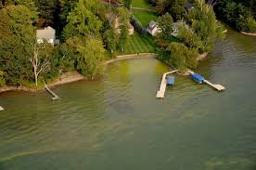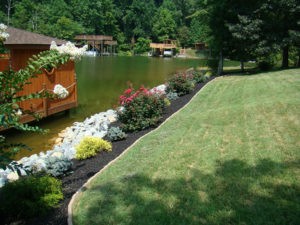27 Mar Buffer Landscape
So, you were attracted to Smith Mountain Lake because of the majesty of the mountain, the tranquility of the countryside and, most importantly, the pristine clarity of the water. If I’ve heard it once, I’ve heard it a hundred times, “I’ve never seen a lake with such beautiful, clear water”. Those of us who volunteer with the Smith Mountain Lake Association agree and believe that it is our responsibility to make sure the friends of Smith Mountain Lake have the awareness and information they need to keep our lake stunningly beautiful. For the past 32 years, SMLA has kept a pulse on the lake’s water quality by working hand in hand with the Virginia Department of Environmental Quality, Appalachian Power Company, Western Virginia Water Authority, Bedford Regional Water Authority and Ferrum College.
In fact, our team of volunteers consider ourselves, stewards of the lake. We, however, are only successful when we have the homeowners on the lake joining us in our mission to protect the health of this watershed. You see, we all have the opportunity (dare I say, responsibility) to positively influence the surrounding areas which drain into streams which drains into our rivers which drains into Smith Mountain Lake, Leesville Lake and the associated tributaries.
One area where we can all make a contribution to our pristine water quality is by being aware of the damage that runoff can cause to our lake. The US Environmental Protection Agency has reported that runoff from lawns, roads and rooftops is a primary cause of pollution of our waterways. The extra fertilizer from lawns, oil and gas from driveways, soil from building sites, litter, pesticides, herbicides and salt are polluting our lake. Water carries these contaminants to our lakes, streams, rivers, and wetlands which fosters the growth of algae. Nutrient pollution from landscape runoff, and failing septic systems can cause explosive algal growth. As the algae die and decompose, they consume dissolved oxygen in the water to the detriment of fish and other organisms that need it. Erosion can cause turbidity (cloudiness) in water, reducing the amount of light penetrating the water. This inhibits growth of aquatic plants that fish depend on. Actually, in the summer the situation is exacerbated due to warmer water which leads to less oxygen available in the water.

Consider what is happening in the state known as The Land of Lakes, Minnesota. Over the last half-century, quaint lakeside cabins have been transformed, by the thousands, into mega-homes with large fertilized lawns running to the water’s edge. Nearby towns have been converted to suburban-style strips with vast parking lots. Add in all the golf courses, faulty septic tanks and minimal shoreline vegetation, and you begin to realize how an exponential increase in unfiltered runoff has remade these lakes into a nutrient soup that’s quite literally suffocating fish and other native species within them. This year’s early halt to walleye fishing on Mille Lacs, the state’s most popular fishing lake, is a particularly ominous example. “It’s death by a thousand cuts,” said Peter Sorensen, a fisheries expert at the University of Minnesota and one of a number of scientists who consider the damage irreversible, given the added realities of a warming climate and a stiff political resistance to land-use changes needed to restore central Minnesota’s lakes. Over the next few generations, those lakes will die.
This certainly strikes at the heart of watershed mismanagement and by no means implies that Smith Mountain Lake has fish health issues; however, Minnesota’s pain provides an uncomfortable example of the harmful effects of improperly managed rainwater runoff management. The goal of The Smith Mountain Lake Association is not to inhibit future development but to ensure that we are all take care of the beautiful gift we have been given to enjoy.
What can we do to help? An easy step we can all take to protect our lake is to plant a Buffer Landscape garden at our shoreline. As you ride around the lake this spring, take note of our neighbors who, by working with AEP, have planted natural gardens along the shoreline that has trees, shrubs and perennials beautifully planted. Areas like these serve as a buffer or filter for runoff, catching sediment, debris and pollutants BEFORE it reaches the lake. The plant roots hold the soil, slowing erosion thus helping water clarity as well as protecting the aquatic habitat. Trees and shrubs near the water’s edge help shade the water keeping the water temperature cooler which improves the habitat for amphibians, fish and other aquatic life. Buffer Landscaping promotes the ideal that lakefront homeowners can have a beautiful lakefront while being lake friendly and environmentally sound.

The Buffer Landscape volunteers are made up of Virginia Master Naturalists and Virginia Master Gardeners. These folks will work with homeowners on garden plans that are designed to manage erosion and provide a natural buffer or filter that will keep harmful sediment, and pollutants out of our lake. It’s an easy collaborative conversation with the homeowners who are in charge of the plan. Our Master Gardeners and Naturalists simply provide recommendation based on what the homeowner tells us they want. The meetings are held at the homeowner’s shoreline where our Master Gardeners and Naturalists work with the homeowner to develop a plan best suited for the homeowner’s goals. It’s that simple.
If you’re interested in getting started give us a call at 540-719-0690 or e mail us at TheOffice@smlassociation.org.



